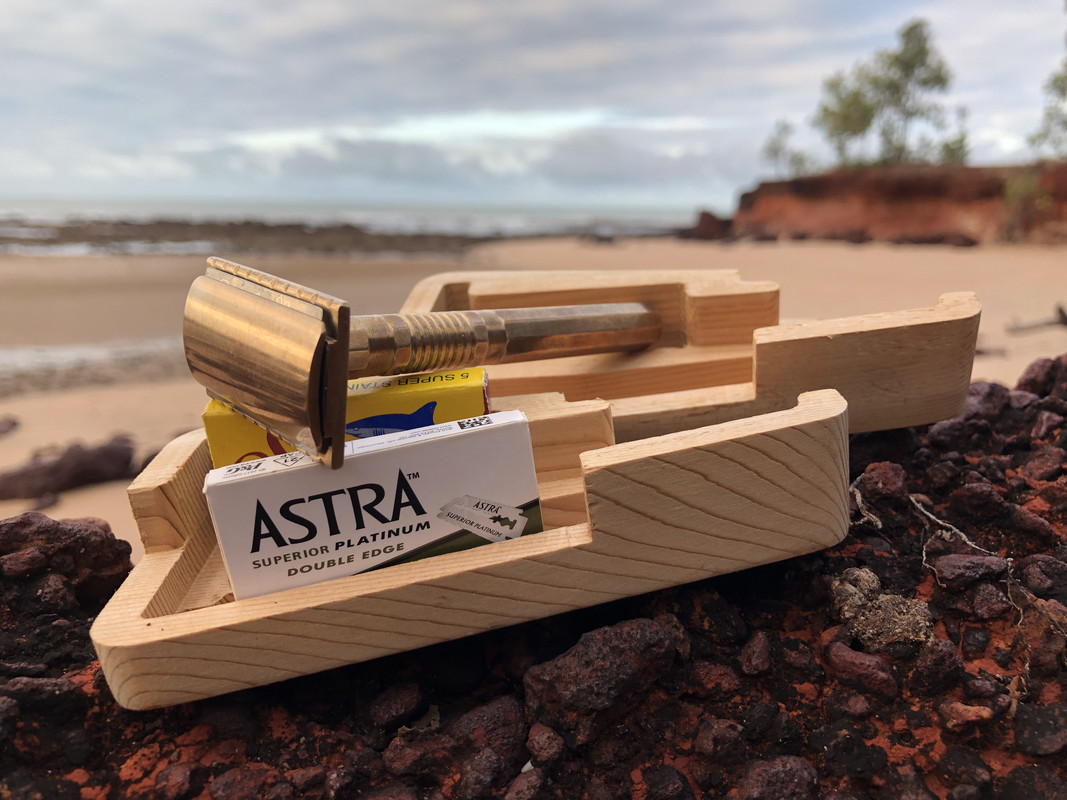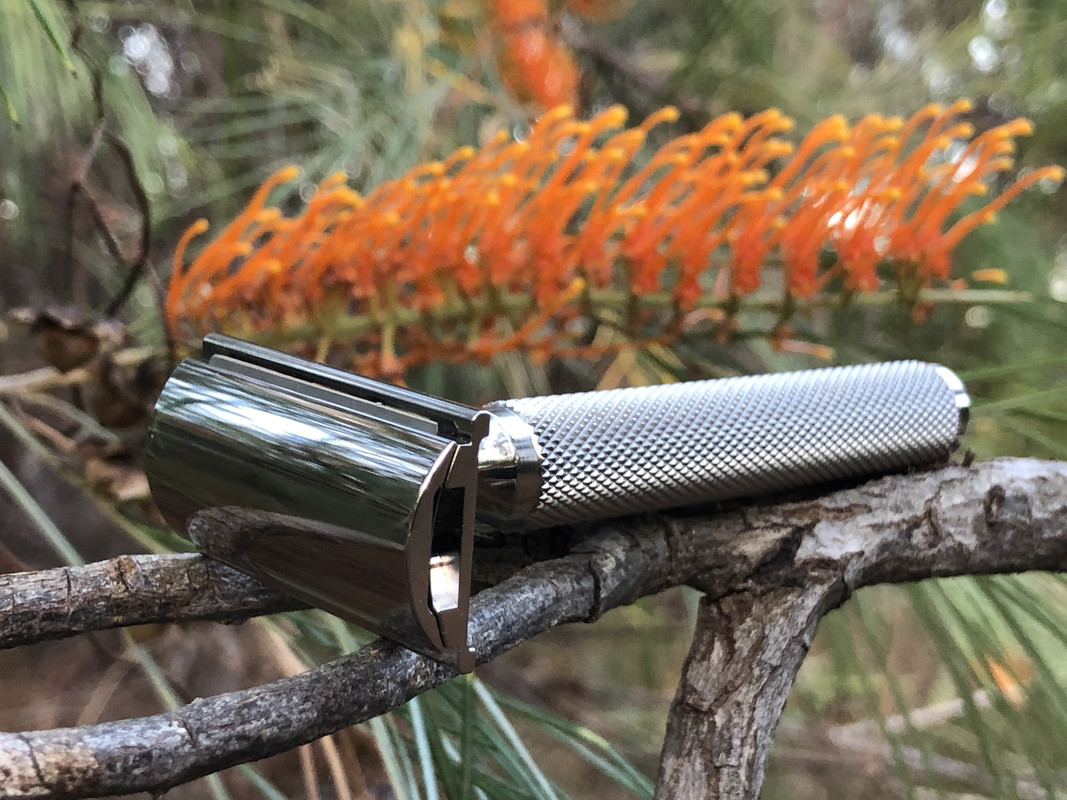Robin Classic DE (Canada)

I didn’t even know of this razor existence until I saw this one advertised for sale the other day, so I ordered it. Robin razors are made in very limited numbers in a small home-based workshop in Montreal. All three components are investment cast from a silicon based bronze alloy and then each piece is machine or hand finished. As I unscrewed the handle, it was disappointing to feel the sloppy fit of the handle thread, it worked, but for a premium priced razor, it needs to be much better. I’m sure I’ve seen a similar styled handle on a vintage razor but I just can’t put a name to that razor; ten sides, with some grooves machined for the forward grip; a bit thin but it looks fantastic in polished bronze and should provide positive grip. A very flat looking cap is utilized which helps minimise the thickness of the head, therefore shaving those difficult to get to areas should be no issue. Investment casting is said to deliver a very accurate reproduction of the part being cast therefore I question why there are what looks like machine marks on the back of the cap. Certainly, they are not visible when the Robin is assembled but it would have improved presentation if all marks were polished out before the casting process commenced; all caps would then have an unmarked back. Very few marks are visible on the plate except for the neat looking Robin Razor emblem; extra polishing is evident along the edges of the plate where face contact is made so I’m expecting a very smooth shave. I don’t often make comment on the cases that razors come in (even if I like to store razors in their original cases) but the Robin case is exceptional. It is a coffin shaped two piece wooden construction where each piece fits precisely into the other section, it’s small but there is enough room for two pucks of blades also.
This is one mild razor with efficiency about that of a Karve CB Level #A. To me mild razors, especially those like this Robin with neutral blade feel, are simply plain hard work. It is frustrating having to continually clean up sections that the razor passed over leaving whiskers still standing. As suggested, this razor felt smooth against the skin and after much tidying up, I achieved an acceptably result but that didn’t last long. Fitting a Feather blade achieved nothing. This razor is not for me. I would like to see a revised model with more efficiency and a more positive blade.
B
lades Used – Rapira Sweedish Supersteel and Feather
Material – Bronze
Blade Tab - Exposed
Weight – 95g
Head Width – 41.52mm
Handle Length – 89.61mm
Across the Flats – 10.43mm
Availability – Etsy
Final Word – Not good
I had never heard of a Robin razor so I had a few questions to ask. I’ve left Sam to describe his own works, which he has done quite admirably.
Hello Errol,
Thank you for your order and interest. Not a nuisance, BTW, I'm happy to give more info - sorry for the delay in responding to your message or order.
No shame in not having heard of the Robin! -- they've only recently been launched. They are indeed made in very small quantities (just getting past made-to-order at this point). (I hope to ramp up production a little toward end of 2021) I make them in my home workshop, and at a local foundry co-op (for cast parts, such as the three bronze components in the classic razor that you ordered).
As for what you can expect, well, the cast bronze Robin Razor is fairly unique in terms of what is on the market. I'm not sure how familiar you are with DESRs (double edge safety razors); I'm under the impression they are not completely new to you - apologies if I'm mistaken.
Most DESRs are made by die-casting, machining or by metal injection molding. In contrast, the Robin bronze classic safety razors are made by investment casting, and are hand finished (with the exception of the base-plate, which I machine finish).
The bronze classic razors are designed to give a fairly mild shave - I wanted to make something that would be a solid daily driver of a razor. There's a bit of a large-ish cap span (distance from edge of blade to edge of cap, which allows the user to get a bit more aggressive of a shave by applying a bit of pressure - should they so desire. Blade has neutral exposure - doesn't stick out from or recess into the cap and baseplate.
Also notable is that there is a fair bit of heft to them (they're made of solid bronze, after all). I'm casting these razors at what is for the most part an art (ie: bronze sculpture) foundry, and so the polished bronze surfaces will indeed change in appearance over time, with the bronze developing a nice patina (a thin oxidised surface layer) - so the character (or at least it's appearance) will change over time. Artists will indeed intentionally add 'artificial' patinas to bronze sculptures. But if you prefer that shiny new look, you can always polish away the patina every so often - just use a super fine abrasive pad or steel wool, and avoid polishing much on the surfaces that actually make contact with the razor blade itself.
A pretty important difference between my cast bronze razors vs a lot of other DESRs is that mine are hand finished. Unlike some of the ultra-precision machined razors out there, mine are by necessity still precision-made (a DESR kind of has to be), but not with as tight dimensional tolerances as you'll get with CNC machined parts. But each Robin component (with exception of base plate) is carefully hand finished and then inspected for quality. An old-fashioned way of making parts for an old invention! Surface markings or superficial casting defects will occasionally be visible, but I always make sure that they are not impinging on the proper fit or dimensions of the critical surfaces (ie: anything that affects blade geometry).
I hope that this gives you a bit of the kind of info you seek. Please let me know if you have further Qs.





